

The warm climate in Texas makes it a natural choice for swimming as a leisure activity. Unfortunately, leisure pools are not without their risks. In fact, they are actively dangerous environments fraught with opportunities for serious injuries and death to occur due to the negligence of the pool owner and neglectful supervision. This is especially true for younger children. It may surprise you to learn that drowning in the leading cause of death for children between ages 1 to 4 years old according to the Centers for Disease Control and Prevention (CDC) with Texas having the third-highest number of drowning-related deaths across the country.
This article will discuss some of the things you can do to protect your children from drowning accidents. It will also equip you with knowledge of the responsibilities of pool owners. If pool owners do not meet these responsibilities, they may be found to be negligent and you may be entitled to compensation if you or a loved one suffers personal injuries due to their actions or inaction.
For more information on how our trial attorneys could help you, call us today for a free consultation. We have a track record of obtaining the highest recorded settlement results in drowning cases, with one case recently paying out $18,000,000 to the family impacted.
To find out more, call today at 713-535-9319.
General Texas Statistics For Drowning Accidents
Drowning accidents are an unfortunately common occurrence in the State of Texas. Here are some statistics from a 2022 report by the Central Texas Drowning Prevention Action Team, that draws on data collected between 2006 and 2020:
- 5,401 people in Texas have died as a result of a drowning accident in the last fifteen years – that is one person each day.
- Texas has the third-highest total number of deaths due to drowning accidents in the whole of the United States.
- Males in Texas are three times more likely to suffer from a fatal drowning accident than females.
- The drowning death rate in Texas appears to be on the rise, with more people having lost their lives in 2020 than in any year before it.
While these statistics are alarming in themselves, things become even bleaker when we unpack the fact that children are at much greater risk of drowning accidents than adults.
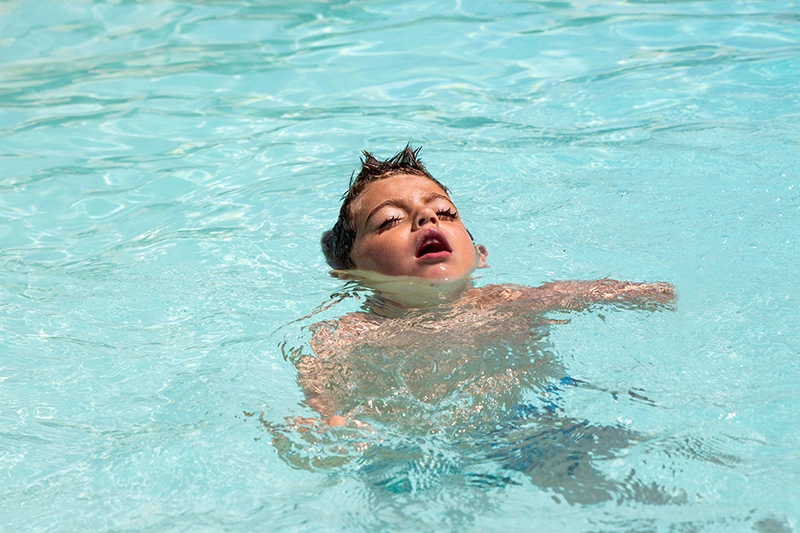
Young Children Are At The Highest Risk Of A Fatal Drowning Accident
The same study mentioned in the section above identified that young children carry the highest risk of fatal drowning accidents.
Texan children between 1 and 4 years old had the highest rate of drowning of all age groups. Not only this, drowning was the highest fatal personal injury occurrence for children in this age bracket – leading to more deaths than birth defects, heart disease, homicide, or cancer combined.
The data tells us more. Infants under 1 year of age are most likely to suffer a drowning accident in the bath. However, between the ages of two and fourteen, the most common causes of drowning accidents are all related to swimming pools. Once a child reaches fifteen, and onward for the rest of their life, the most common cause of drowning involves natural bodies of water.
Tips For Keeping Children Safe Around Water: Advice From a Houston Drowning Accident Lawyer
Now that we have seen how dangerous swimming pools and other drowning-related risks can be for young children up until the age of fifteen, we will explore some tips and advice to help parents prevent their children from suffering drowning or other swimming pool-related injuries.
Children Should Start Swimming Lessons As Early As Possible
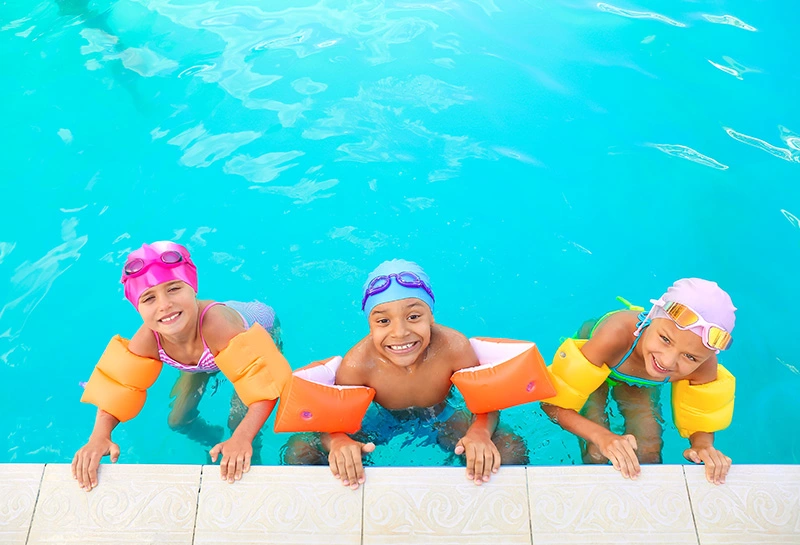
As a parent, one of the most important things you can do is to get your child involved in swimming lessons as early in their life as possible. Even at one year of age, a child can begin swimming lessons – although make sure you do your research and find a safe provider, and potentially keep an eye on their lessons yourself.
Looking at the statistics, where males are three times more likely to drown than females, it could be argued that this is even more important if you have a young male child.
As well as practical swimming lessons, the importance of education around the possibility of a swimming pool accident should not be underestimated. Children should be made aware of the dangers of a drowning accident, how easily they can happen, and the consequences of getting in a pool unattended.
Never Leave Your Children Unattended Around Baths, Pools, Or Other Bodies Of Water
It may seem obvious to state that young children should not be left unattended around swimming pools or bodies of water. However, not all drownings occur when children are totally alone, many occur when there is (or there is supposed to be) a lifeguard on duty. Lifeguard negligence is an unfortunately common element of a drowning accident case.
The only way to truly ensure your child’s safety is to actively keep an eye on them at all times. This is especially true in today’s age where cell phones and other devices constantly compete for our attention. To better assist you in always being able to see your children, choose swim outfits that are brightly colored, rather than colors that potentially blend into the color of water and other natural surroundings.
For extremely young children, (especially infants one year old or less), adults should apply the same active supervision standard to bath time, no matter how shallow the water may be.
Finally, adults should have heightened awareness when at the beach, public pool, or other crowded areas near a body of water. If you are sharing supervision responsibilities with a co-parent or other adult, make sure you have a clear plan as to who is watching the child at all times. Do not assume that a lifeguard or staff member at the aquatic facility will adequately – and actively – supervise your child for you, or that they are competent enough to prevent an accidental drowning from happening.
Make Consistent Use Of Flotation Devices
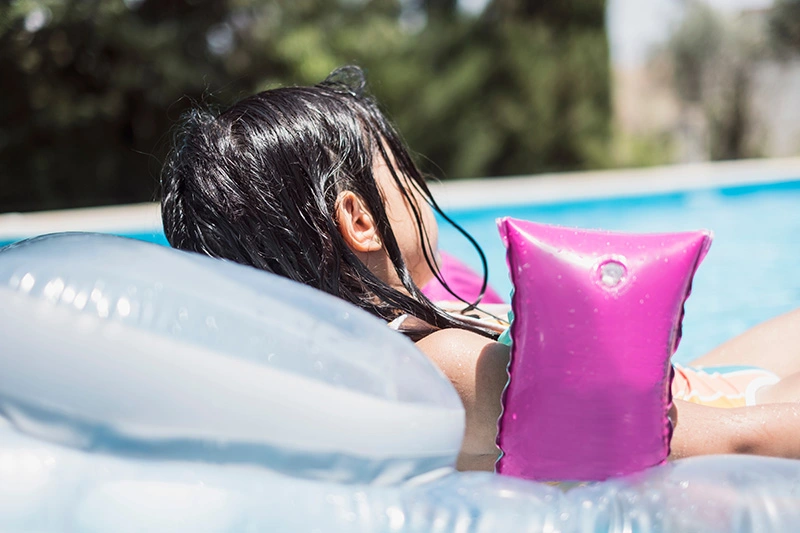
Even if you keep an eye on your children at all times, accidents can still happen. Family members can reduce the risk to young children by ensuring that their children are always equipped with a flotation device, even when they are under close supervision.
There are numerous flotation devices available. You might want to consider water wings, life jackets, foam flotation devices, lilos, rubber rings, or any combination of the various other flotation devices on the market. If you have enrolled your child in swimming lessons, ask their swim coach what the best flotation device for your child is based on their swimming level, age/size, and specific needs. If you do utilize any flotation devices, make sure you completely read the warnings and product recommendations/instructions to ensure that the product is appropriate for your child’s age and size, and that you have correctly adjusted the device for your child’s personal use. Finally, the use of flotation devices is merely an additional safety measure and should never be considered a replacement to your active supervision of your child.
Ensure Any Pool On Your Property Is Appropriately Inaccessible
Pools are an alluring prospect for most children, many of whom do not recognize or appreciate the extent of danger inherent in these areas. Texas laws in fact recognize the disparity between an average child’s limited perception of danger compared to the dangers that pools and other bodies of water actually present through the Attractive Nuisance Doctrine. These laws prevent pool and other owners with bodies of water to lay blame to children that are severely injured or killed by these dangerous conditions.
Texas also sets forth strict statutory regulations that require public pools to be physically inaccessible to children who are unaccompanied by adults. While these regulations help prevent children from accessing public pool areas without adult supervision, there are many instances where apartments and other public pool operators fail to keep their gates and fences in good working order. If you live in an apartment complex or are staying with a child on a commercial property that has a pool area, make sure the area is equipped with gates that have functional self-latching mechanisms that cannot be reached or opened by your child.
It is also important to note that few regulations apply to private pools at homes throughout Texas. If you have a private pool or are staying with someone that has a private pool – no matter how short a period of time – it is crucial to understand the extent the homeowner has any barriers or other mechanisms to prevent children from accessing the pool area without supervision. Finally, make a plan as to how you will supervise your child to ensure they do not enter the pool area without appropriate supervision.
This is one of the most common causes of drowning and near-drowning accidents to befall young children.
How Drowning Occurs
Now that we have looked at young children specifically, we will go on to explore how drowning occurs more generally. This information will be relevant for young children, as well as anyone else who finds themselves involved in a potential drowning accident.
The main dangers of a drowning accident come in the following forms:
- The victim going into shock as a result of sudden immersion into the water, especially if the water is cold;
- The additional weight of water-saturated clothes, this can make swimming much more difficult than the victim is used to;
- The chances of incapacitation if the victim hits their head on something, such as debris, the floor of a swimming pool, or any other environmental hazard on their way into the water;
- Tiring out and succumbing to exhaustion or fatigue before a successful rescue can take place;
- Hypothermia if the victim has become submerged in cold water (this can continue to be a risk even after the victim has been successfully rescued) and
- Dry drowning, where water does not reach the lungs but instead causes the victim’s vocal cords to spasm and seal.
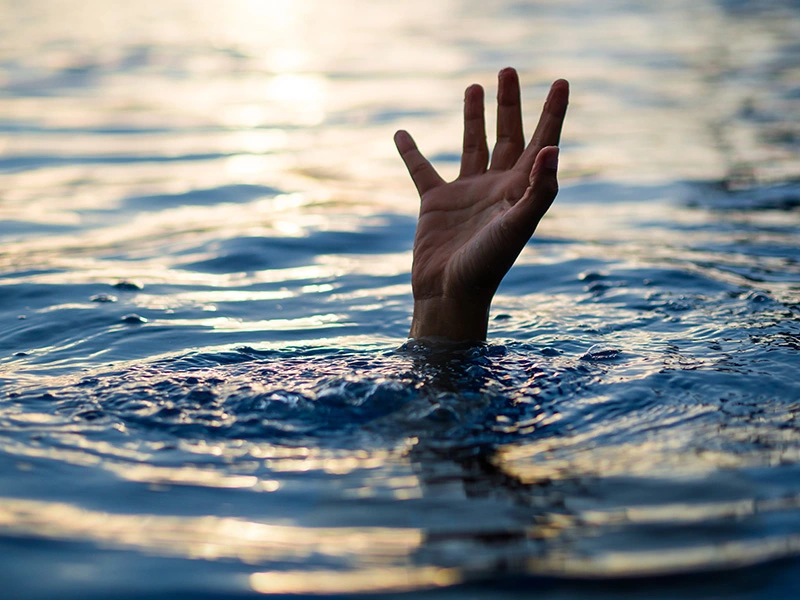
Common Causes Of Swimming Pool Accidents
There are a number of common causes of drowning accidents involving pools. It can help to be aware of these to prevent a similar accident from befalling your loved ones.
Common drowning or near drowning causes include:
- Young unattended swimmers;
- Antiquated pool drain and suction systems trapping swimmers, which is especially a risk for younger children or more small-framed individuals;
- Children being tempted by an alluring pool, spa, or hot tub that has not been properly secured with appropriate fences, gates, and locks;
- Cloudy, poorly cleaned pools with poor visibility that make it difficult to locate a drowning victim; and
- Absent or negligent lifeguards and adult caretakers.
Many of these causes carry the possibility of being due to the negligence of the property or pool owner. If this is the case, you could be entitled to compensation for any injuries, complications, or familial losses that resulted from the accident.
A Houston Drowning Accident Lawyer Is Here To Help With Your Personal Injury Case

The drowning accident lawyers here at Abraham Watkins have a wealth of experience when it comes to handling injury cases as a result of swimming pool accidents. We have the skills and capacity to dedicate to your case to help you stand the best chance at maximizing the compensation you could be owed.
We recently won a case for a family who suffered the tragedy of a child drowning accident. The case settled for $18,000,000. While no amount of money will make up for the tragic events or ease the family’s grief, the sum is an important sign of justice over property owners whose negligence caused this unthinkable loss.
If you or your family has been impacted by a drowning accident, our team of Houston drowning accident lawyers is here to work tirelessly to win you the compensation you deserve. For more information on how we can help with your specific case, call us today for a free legal consultation.
How A Houston Drowning Accident Lawyer Could Help You
If you or a family member has been involved in a swimming pool or other type of drowning accident, one of the personal injury lawyers from our law firm can help you to seek the compensation you deserve.
An experienced Houston drowning accident lawyer could help you:
- Know how much your drowning or near drowning case could be worth.
- Collect key evidence to prove negligence on the part of the property owner, demonstrating your entitlement for compensation.
- Handle the administrative and bureaucratic complexities involved in a personal injury case.
- Assist you in negotiating a favorable settlement from your insurance company, while helping you ensure that you do not accidentally lower the worth of your claim.
- Argue your case in court to give you the best chance of earning compensation from the judge.
For more information on how the team of drowning accident lawyers from our law firm could help you with your case, call us for a free consultation today.
What Types Of Compensation Do Houston Drowning Accident Claims Usually Result In?
If you or a member of your family has suffered injuries or complications due to pool owner negligence, you are likely entitled to compensation for your economic and noneconomic losses.
The types of compensation that your personal injury lawyers may be able to help you access will be different depending on the specifics of your case. We will discuss the different categories in the sections below, explaining how they work and what evidence may be able to further your case.
Generally speaking, the more severe the consequences, the greater the level of compensation you can expect to receive. For example, a serious injury is likely to lead to more compensation than a more minor injury.
Compensation For Medical Expenses

Compensation For Medical Expenses
A near-drowning accident may incur serious medical bills, especially if emergency services need to be called to provide on-site medical attention. If you can prove that the personal injury was the result of somebody else’s negligence, you may be able to claim these expenses back.
For the best chance of receiving compensation for medical expenses incurred when the accident occurred, you will need to provide your drowning accident attorneys with evidence of the expenses. As such, you should keep copies of all hospital bills and all other medical documentation surrounding the event.
Compensation For Lost Wages
It is not uncommon for adult victims of drowning accidents to require time off from work in order to recover from their injuries. Unfortunately, this will often mean that a person receives reduced or no pay during this time, impacting their household income.
Your Texas drowning accident lawyers will be able to help you claim for compensation to reimburse you for earnings lost during this time. In order to ensure you have sufficient evidence for your claim, you should provide your legal team with pay stubs showing how much you usually earn.
You should also keep copies of all correspondence with your employer concerning your time off – this correspondence should always be in writing so that there is a usable record for your personal injury case.
Compensation For Out-Of-Pocket Expenses
We have covered the main two areas of economic damages following many drowning accidents above. However, there are many other factors that could cause you otherwise avoidable expenditure.
These might include additional necessary childcare expenses, transportation costs to and from appointments, and other expenditures that would not have been needed if you had not been the victim of an accident. Personal accident cases can include compensation for these additional out-of-pocket expenses. You will, however, need to provide evidence and a case for these expenses.
As a rule of thumb, you should keep receipts for any expense that you believe would have been avoidable had you not experienced the accident. Your Houston drowning accident attorney will be able to advise whether you stand a chance of being reimbursed for them.
Compensation For Pain And Suffering
Pain and suffering damages attempt to provide a level of compensation based on the duration, pain level, and consequences of your recovery process. They will factor in the length of your recovery process and the severity of your injuries. They will also consider whether you have any permanent impact on your life going forward, such as a disability, disfigurement, impairment, or any psychological trauma.
There are two main ways of calculating the compensation amount for pain and suffering damages: the per diem method and the multiplier method. However, insurance companies and courts are not obligated to use these methods, and other methods may be used instead – such as previous precedents or computer calculation programs.
The per diem (meaning ‘per day’ in Latin) calculates your pain and suffering compensation at a daily rate for each day of your recovery process. An economic amount is calculated by looking at damages such as lost wages and medical costs. This is then multiplied by the number of days you spent recovering from the accident.
The multiplier method also takes a base economic amount in a way similar to the per diem method – but it uses the total expense rather than a daily rate. The multiplier method then multiplies this amount by a number between 1 and 5, with more serious injuries receiving a higher number. The resulting amount is then your pain and suffering compensation.
Punitive Damages
Punitive damages are designed to punish a property owner and other defendants when their gross negligence causes or contributes to the cause of another’s injuries. Considering that negligence by swimming pool owners is a common cause of drowning accidents, punitive damages are not uncommon in drowning cases.
Compensation For A Wrongful Death
If you have lost a member of your family to a drowning accident, you will likely be able to make a wrongful death claim to seek compensation for your loss. This type of claim is not like an accusation of murder or manslaughter. A wrongful death lawsuit is a civil lawsuit; you can claim for an unintentional death as long as it was caused by the negligence of another person. Being a civil lawsuit, the burden of proof is also lower than with a criminal accusation.
It may seem unthinkable to consider money after the loss of somebody close to you. However, the passing of a loved one often comes with huge expenses that we do not consider. Wrongful death damages are designed to cover the cost of funeral and burial expenses. They also provide the surviving family with compensation for lost household income, loss of companionship, loss of consortium, and other emotional impacts.
However, only certain parties can file wrongful death claims in Houston, Texas. These parties are:
- The deceased’s spouse
- The deceased’s children
- The deceased’s parents
Unfortunately, if you are not one of the parties above, Texas law does not allow you to raise a claim, no matter how close you may have been to the person who lost their life.
The Statute Of Limitations On A Personal Injury Claim For A Drowning Accident
In Texas, there is a time limit on how long after an accident you can raise a personal injury claim. This is known as the statute of limitations. This period is two years from the date the accident occurred, and is the same for both personal injuries and wrongful deaths.
Two years may seem like a long time. However, this should not be cause for you to delay unnecessarily. You should contact a drowning accident attorney as soon as possible to begin your case as timing is generally critical to ensure all evidence regarding the cause of the drowning is properly collected.
This is because key evidence may easily become lost over time. It is also possible that your insurance company or the property owners have their own legal teams working the case. If that is the case, you will need as much time to build a strong case as possible in order to maximize the compensation you could be owed.
Houston Regulations For Apartment Complex Swimming Pools
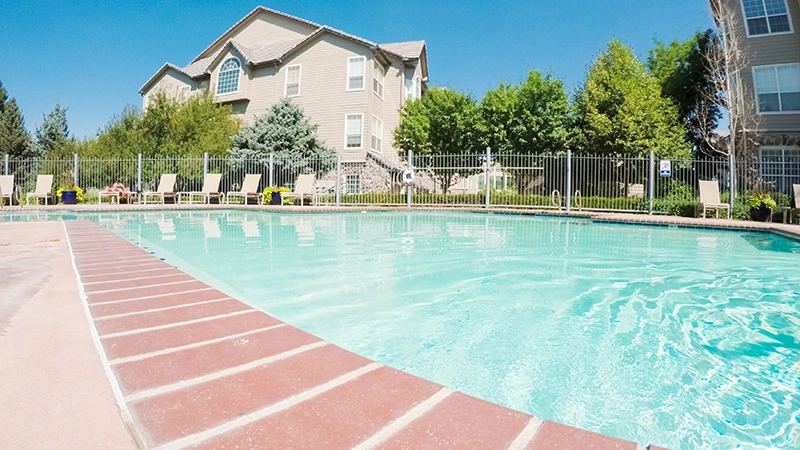
Pools
The State of Texas has a number of very specific regulations in place concerning swimming pools in apartment complexes. These exist to reduce the risk of drowning accidents or other poolside injuries.
Texas law requires pool owners to follow strict guidelines in order to stand the best chance of preventing a pool accident. If an apartment complex is in violation of any of these regulations, they may be found to be negligent, or grossly negligent, and therefore could be responsible for any injuries or drowning accidents that take place at their pool. A case of negligence would also often mean that the injured party or their relatives (in the case of a wrongful death by drowning) could be entitled to compensation.
The following sections will break down Texas apartment complex swimming pool regulations into the following categories:
- Pool construction;
- Health and safety equipment;
- Required warning signs;
- Water clarity;
- Chemical regulations; and
- Staff training.
Pool Construction Regulations For Houston Apartment Pools
Any pool area in an apartment complex must meet certain safety standards as per Texas regulations.They were designed to prevent accident drownings and deaths at public pools in Texas, and are largely aimed at making it impossible for unattended children to access swimming pool areas without appropriate adult supervision.
Pool construction regulations can be broken down into the following categories:
- Walls
- Gates
- Windows and doors
These rules apply to both permanent pools and temporary ones, as both classify as an attractive nuisance that could result in children becoming drowning victims.
Houston Apartment Complex Pool Wall Regulations
Firstly, all pools constructed in Houston must have a wall that is at least 4 feet (48 inches) tall. It must be constructed from a solid, non-climbable substance – so materials such as chain links are inappropriate.
Horizontal slats are only allowed on the inside of the wall, as they could allow for easy climbing. If there are gaps in the fence, they must be no greater than 4 inches wide. Any decorative opening must not be bigger than 1.75 inches in every direction.
Houston Apartment Complex Pool Gate Regulations
Houston has similar rules for gates as it does for pool walls. Any gate in these walls must be at least the same height (4 feet) and adhere to all of the other wall-related criteria above.
Gates must also be self-closing and must lock automatically. The gate must also open away from the pool area. Finally, the locking mechanism must be complex enough that an unattended young child would be unable to open it.
Houston Apartment Complex Pool Regulations For Doors And Windows
Similar rules exist for doors and windows that open directly onto a pool area. Doors must have a keyless bolting lock that is 36 inches above the ground. If the doors are French doors, they should feature a deadbolt lock. If the doors are sliding doors, they should feature a bar-and-pin lock.
Any window that could provide access to the pool must be sealed permanently.
Health And Safety Equipment Required For Houston Apartment Complex Pools
Apartment complexes must have certain items of health and safety equipment on hand at all times to prevent the worst consequences of swimming pool accidents.
These include:
- Ring buoys, throwing ropes, and reaching poles – these are standard equipment for retrieving swimmers in distress from a body of water. One of each item is required for each 2,000 square feet of pool surface area – up to a total area of 6,000 square feet. Once 6,000 square feet has been reached, the pool needs another set for every extra 4,000 square feet of area. All of these pieces of equipment must be easily visible and accessible anywhere in the pool zone.
- Emergency summoning device – a device capable of summoning the emergency service (a regular phone will suffice) must be reachable within 200 feet of the pool. This should be clearly visible, labeled, and accompanied by a sign detailing the address of your property and additional contact information.
- Pool alarm – as well as all of the construction specifications in the sections above, any pool must be equipped with an alarm that will be triggered if these boundaries are breached without somebody noticing.
- Durable thermometer (for spas) – if the apartment complex pool features spa facilities, the Spa Safety Act states that it must be equipped with a break-resistant thermometer that is accessible by both staff and patrons so that they can monitor the temperature. This thermometer must be accurate within 1 degree Fahrenheit.
- Skimmer weirs – if the apartment complex pool features skimmers, each one must have a dedicated weir. These weirs must automatically adjust to fluctuations in the water height, up to a maximum of 4 inches.
Required Warning Signs For Houston Apartment Complex Pools
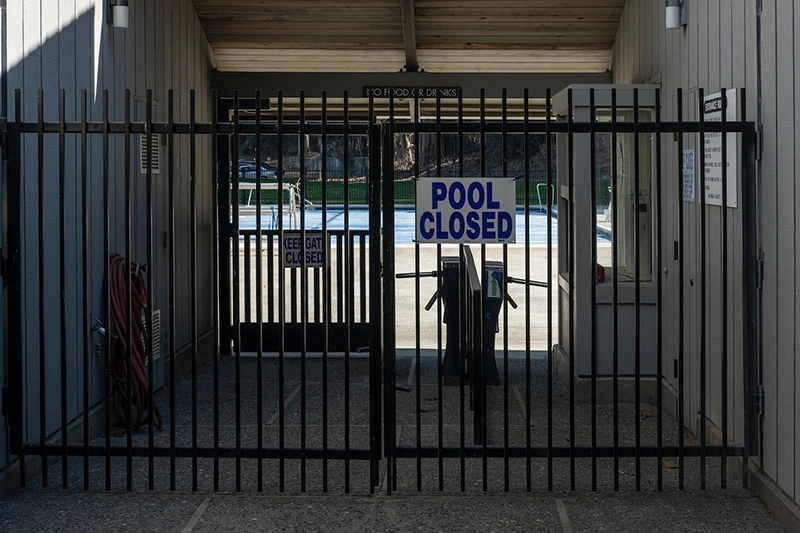
Even if the construction regulations and health and safety equipment procedures have been followed to the letter, pool owners may still be found to be negligent if they have not provided the correct signage.
A pool requires the following sized signs:
- ‘WARNING: NO LIFEGUARD ON DUTY’ – minimum letter size of 4 inches, placed in any pool area where a lifeguard is not provided or required at all times.
- ‘NO DIVING’ (accompanied by the international no diving symbol) – minimum letter size of 4 inches, placed in any pool area where a lifeguard is not provided or required at all times.
- ‘IN CASE OF EMERGENCY, DIAL 911’ – minimum letter size of 4 inches, required in all pools.
- ‘PETS IN THE POOL ARE PROHIBITED’ – minimum letter size of 2 inches, required in all pools.
- DO NOT SWIM IF YOU HAVE BEEN ILL WITH DIARRHEA WITHIN THE PAST 2 WEEKS – minimum letter size of 2 inches, required in all pools.
- CHANGING DIAPERS WITHIN 6 FEET OF THE POOL IS PROHIBITED – minimum letter size of 2 inches, required in all pools.
- GLASS ITEMS NOT ALLOWED IN THE POOL YARD – minimum letter size of 2 inches, required in all pools.
- PERSONS UNDER THE AGE OF 14 MUST NOT BE IN THE POOL WITHOUT ADULT SUPERVISION – minimum letter size of 2 inches, required in all pools.
- EXTENDED BREATH HOLDING ACTIVITIES ARE DANGEROUS AND PROHIBITED – minimum letter size of 2 inches, required in all pools.
- Precise location of the pool’s address and emergency telephone number – minimum letter size of 1 inch, required in all pools next to the emergency summoning device.
- Hours of operation – minimum letter size of 1 inch, required in all pools.
- Maximum number of pool users – minimum letter size of 2 inches, required in all pools.
A pool that includes spa facilities must have these additional signs:
- ‘WARNING: NO LIFEGUARD ON DUTY’ – minimum letter size of 4 inches, placed in any spa area where a lifeguard is not provided or required at all times.
- ‘DO NOT USE THE SPA IF THE WATER TEMPERATURE IS ABOVE 104 DEGREES FAHRENHEIT ‘ – minimum letter size 1 inch, required in all spas.
- ‘EMERGENCY SPA SHUTOFF’ – minimum letter size of 2 inches, required to be placed next to the emergency spa shutoff button.
- ‘PETS IN THE SPA ARE PROHIBITED’ – minimum letter size of 2 inches, required in all spas.
- DO NOT SWIM IF YOU HAVE BEEN ILL WITH DIARRHEA WITHIN THE PAST 2 WEEKS – minimum letter size of 2 inches, required in all spas.
- Maximum number of pool users – minimum letter size of 2 inches, required in all spas.
- Notification of the location of the nearest emergency phone or similar device – minimum letter size of 2 inches, required in all spas.
Pipes and chemical bulk tanks must also be labeled appropriately. Chemical bulk tanks and day tanks must be labeled with their contents. Pipes must be labeled with their function and the direction (using arrows) of the flow of the liquid or gas inside of them. This is a requirement no matter when they were constructed.
If the apartment complex is located in an area where a large percentage of the population are non-English speakers, these signs must also be displayed in the predominant alternative language spoken in that area.
Water Clarity Regulations For Houston Apartment Complex Pools
For a pool to be at the required clarity, the following things must be true:
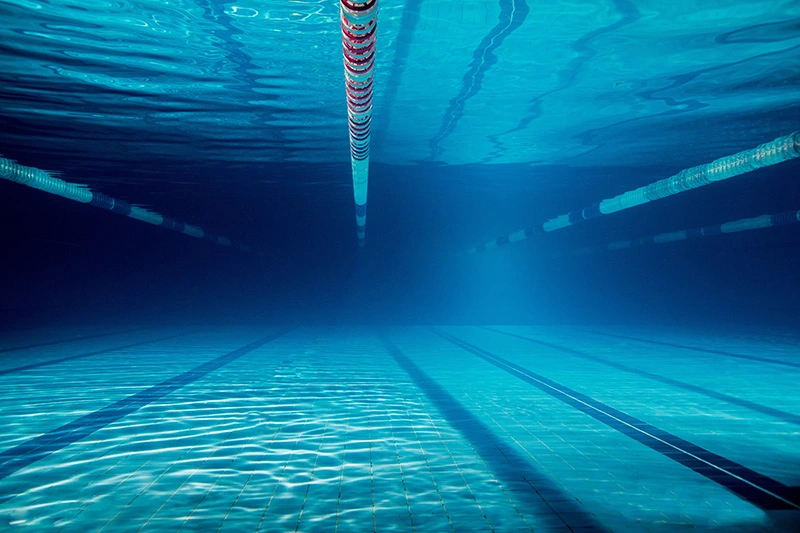
Clarity, simply meaning the clearness of the pool’s water, is also legally regulated in Texas to prevent submersion injuries.
For a pool to be at the required clarity, the following things must be true:
- The pool’s bottom must be completely clearly visible
- All main pool drains should be visible from the pool’s edge
- There should be no noticeable debris or sediment in the water; this point should be checked both before the pool opens for the day and periodically throughout its open period
- There should be no growth of algae – if algae has grown, this is a sign of poor pool sanitation
- There should be no unpleasant odors present
Pool owners can check their pool clarity using a Secchi Disk or any other 8-inch black disk. This should be placed on the bottom of the pool at its deepest point, and a person standing on the closest side of the pool to the disk should be able to easily see it.
Chemical Testing Regulations For Houston Apartment Complex Pools
Legislation also states the acceptable ranges for pool chemicals. These set out a minimum level, a maximum level, and an ideal level.
For pools, these are as follows:
- Chlorine – 1 – 8 ppm, with an ideal of 2 – 3 ppm. To be tested daily.
- Bromine – 3 – 10 ppm, with an ideal of 4 -6 ppm. To be tested monthly, but recommended to be tested weekly.
- pH – 7 – 7.8, with an ideal of 7.2 – 7.6. To be tested daily.
- Cyanuric acid – 0 – 100pm, with an ideal of 30 -50 ppm. To be tested weekly.
- ORP – 600 – 900 mV, with an ideal of 650 – 750 mV. To be tested monthly.
- Alkalinity – 60 – 180 ppm, which is the same as the ideal range. To be tested monthly, but recommended to be tested weekly.
- Calcium hardness – 150 – 1000 ppm, with an ideal of 150 -400 ppm. To be tested monthly, but recommended to be tested weekly.
- Algae – zero, no algae is ever acceptable. To be tested monthly, but recommended to be tested weekly.
Most of these are the same for spas, with the following exceptions:
- Chlorine – 2 – 8 ppm, with an ideal of 3 ppm.
- Bromine – 4 – 10 ppm, with an ideal of 5 ppm.
- Calcium hardness – 100 – 800 ppm, with an ideal of 150 – 400 ppm.
The readings for all of these tests must be recorded in the owner’s pool chemical log on the day they are tested. Records going back at least two years (or since the opening of the pool, if it has been open less than two years) must be available within five working days of a request being made for them.
Reliable testing methods must always be on hand at the pool facility and must be stored appropriately, according to the instructions set forth by the manufacturer. This usually means somewhere away from extreme temperature fluctuations, and exposure to water or chemical products.
Similarly, all equipment and reagents for sanitizing, disinfecting, or otherwise controlling chemical levels must be continuously well-stocked, appropriately stored, and meet all manufacturer-recommended instructions.
Staff Training Regulations For Houston Apartment Complex Pools
Any apartment complex with a pool must employ a certified pool operator. They should be certified through one of the following state-approved courses:
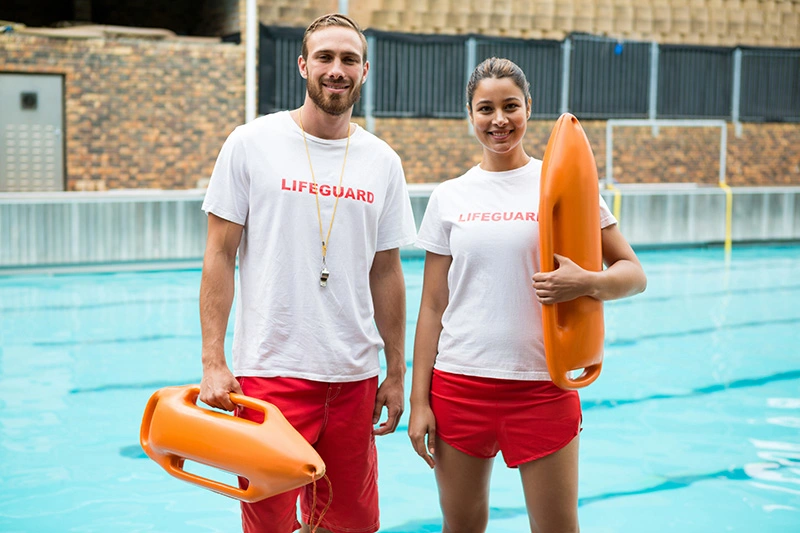
- NRPA – as an Aquatic Facility Operator.
- ASPSA – as a Licensed Aquatic Facility Technician.
- PHTA – as a Certified Pool Operator.
The certified pool operator does not have to be on the grounds at all times. However, their contact information, name, and certification must be instantly available to the management team of the property or any regulatory authority who wishes to see them.
Additionally, all pool maintenance staff must be trained in pool disinfection and sanitation, as per the guidelines in the section above. As well as this, they must be provided with the appropriate personal protective equipment (PPE) to do their jobs, usually meaning goggles and rubber gloves. They must also have all relevant safety information and data sheets available to them.
Our Houston Drowning Accident Lawyers Could Help You
If you or a family member has been involved in a drowning or other pool-related accident within the last two-year period, our legal team could help you to unlock the compensation you deserve for the injuries, complications, and losses that you suffered as a result.
It all starts with a free consultation. Over the phone, we will listen to the details of your accident in a fully confidential environment and give you an idea of what your legal process would look like, including an estimate of how much you could stand to gain in compensation.
For more information about how our law firm could help you, call us today at 713-535-9319.
Free Consultation
We offer a free consultation to prospective clients. If you have been injured and wish to speak to one of our attorneys in a no-cost consultation, please call us at (713) 222-7211. or toll free at 713-222-7211


























